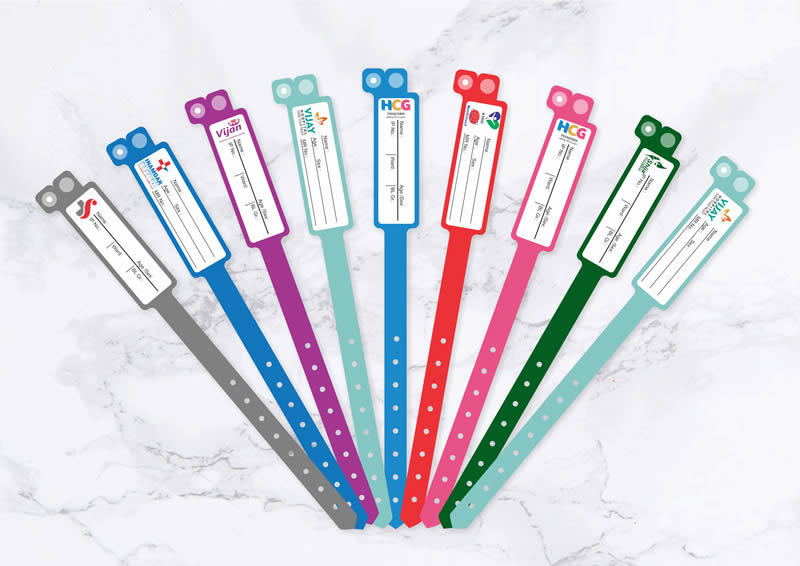The Relationship Between a Patient Identification Band and Enhanced Patient Privacy
The Relationship Between a Patient Identification Band and Enhanced Patient Privacy
Blog Article
Exploring the Different Sorts Of Patient Identification Band Made Use Of in Clinical Facilities
In the complex world of health care, the important role of Patient Identification bands often goes unnoticed. These bands, varying from simple paper wristbands to sophisticated RFID bands, form the backbone of Patient safety and security procedures, making certain precision in Patient Identification. Yet, the substantial variety of these bands, each with its unique benefits and limitations, is often forgotten. As we navigate via this subject, one may gain understanding into the refined complexities and vital value of such bands in clinical centers.
Understanding the Significance of Patient Identification Bands
While they might appear like mere devices, Patient Identification bands play a crucial function in clinical centers. These bands serve as an important device for verifying Patient identity, stopping medical mistakes associated to misidentification. Patient Identification bands likewise aid in enhancing management tasks, making sure precise record-keeping and invoicing.
Traditional Paper Wristbands: Their Usage and Limitations
Typical paper wristbands have actually been a staple in Patient Identification across different clinical facilities. While their use is extensive, they harbor specific limitations that may influence their effectiveness in Patient management. This section will certainly concentrate on the range of their application and the fundamental drawbacks connected with their use.
Paper Wristbands: Usage Scope
In the realm of Patient Identification, paper wristbands have actually long held a vital function. These bands are normally utilized in outpatient settings, where the Patient's remain is temporary. Regardless of innovations in technology, the modest paper wristband continues to be a dependable and cost-efficient option for Patient Identification in numerous health care situations.
Limitations of Paper Wristbands
Despite their widespread use, paper wristbands are not without their drawbacks. In addition, paper wristbands usually do not have the technological capabilities of even more modern options, such as barcoding or RFID chips, limiting their capability to just showing written info. Paper wristbands can cause discomfort or skin irritability to some individuals, specifically when put on for extensive periods.
Barcoded Wristbands: Improvements in Patient Identification
While Patient Identification has actually long been an essential facet of healthcare, the development of barcoded wristbands indicates a significant leap onward. These bands take advantage of the simpleness of barcoding modern technology, permitting Patient details to be swiftly scanned and accessed. They boost the rate and accuracy of Patient Identification, minimizing the danger of medical mistakes related to misidentification. Barcoded wristbands are cost-effective, simple to generate, and get rid of handwriting mistakes typical with hands-on systems. They are not without constraints. While they use improvements over conventional bands, the barcode can come to be smudged or worn, providing it unreadable. Despite this, barcoded wristbands stay a crucial tool in modern medical care settings, symbolizing the junction of innovation and Patient treatment.
Radio Regularity Identification (RFID) Bands: an Action Towards Futuristic Healthcare
The development of Patient Identification bands has produced the introduction of Superhigh frequency Identification (RFID) Bands (patient identification band). These innovative devices present vital benefits for healthcare facilities, using an extra efficient and highly progressed ways of Patient Identification. The implementation of RFID in healthcare is a substantial action towards an extra advanced method to Patient administration and safety and security
Understanding RFID Bands

RFID Bands: Secret Advantages
Embracing a future where technology and medical care merge, radio regularity Identification bands supply several key advantages. Primarily, these bands enhance Patient safety by offering exact, instant Identification, thereby minimizing medical errors. RFID bands can save a large quantity of Patient information, including case history and allergic reactions, making it possible for individualized treatment. They additionally simplify administrative jobs, as the automated information access replaces manual processes, enhancing performance and lowering documents. In addition, RFID bands use real-time monitoring of individuals, important in high-risk environments such as surgical procedure or extensive treatment. These bands are long lasting and immune to environmental variables, guaranteeing regular functionality. Generally, RFID bands stand for a significant innovation in Patient Identification innovation, benefiting both patients and health care carriers.
Executing RFID in Medical Care
As we enter a technically advanced age, the implementation of RFID bands in health care becomes increasingly important. These bands offer a seamless method to track and recognize people, ensuring their safety and security and boosting performance in therapy procedures. RFID bands supply numerous benefits over traditional visit the website Identification methods. They can store a huge quantity of data, including the Patient's case history and therapy strategies, which can be quickly accessed by doctor. This data helps doctors make informed choices pertaining to the Patient's therapy strategy. RFID bands lower medical errors by giving exact Patient Identification, which is critical in avoiding misdiagnosis or wrong medication administration. Thus, the execution of RFID bands is a significant step in the direction of boosting Patient safety and security and medical care delivery.

Color-Coded Wristbands: Assisting in Quick and Accurate Diagnosis
In the bustling setting of a medical facility, color-coded wristbands have arised as you can find out more important tools for swift and precise Identification of a patient's medical condition. These wristbands, worn by individuals, carry details shades that correspond to different medical conditions or conditions. This system is designed to provide prompt visual cues to medical care carriers, enhancing Patient safety and care high quality.
Techniques for Efficient Execution and Monitoring of Patient ID Bands
Achieving optimal use Patient Identification bands requires a well-structured approach for their application and management. The very first step entails training all health workers on the importance of properly using and reviewing these bands. Secondly, hospitals ought to systematize making use of ID bands across all divisions, ensuring uniformity and decreasing disparities. Routine audits should be carried out to confirm adherence to plans and to remedy any type of variances. Patient education and learning is also important; people have to understand the purpose of the bands and the demand for their consistent wear. patient identification band. It's essential to have a back-up plan in area, such as barcode scanning or biometrics, to make certain that Patient Identification is never endangered.
Final thought
Patient Identification bands are crucial in medical centers to make sure security and accuracy. Typical paper, barcoded, RFID, and color-coded wristbands each hold one-of-a-kind benefits, varying from cost-effectiveness to innovative information storage and instant clinical notifies. Reliable application and monitoring of these bands can considerably lower medical errors, improve performance, and improve total Patient care. Therefore, understanding and making use of these Identification devices is extremely important for keeping high standards in health care.
These bands, differing from simple paper wristbands to advanced RFID bands, develop the foundation of Patient security methods, guaranteeing accuracy in Patient Identification.The advancement of Patient Identification bands has actually click now brought regarding the introduction of Radio Regularity Identification (RFID) Bands. Generally, RFID bands stand for a significant advancement in Patient Identification modern technology, profiting both people and medical care service providers.
RFID bands decrease medical mistakes by giving exact Patient Identification, which is important in stopping misdiagnosis or wrong medication management. Patient education and learning is likewise essential; clients should understand the objective of the bands and the demand for their continuous wear.
Report this page